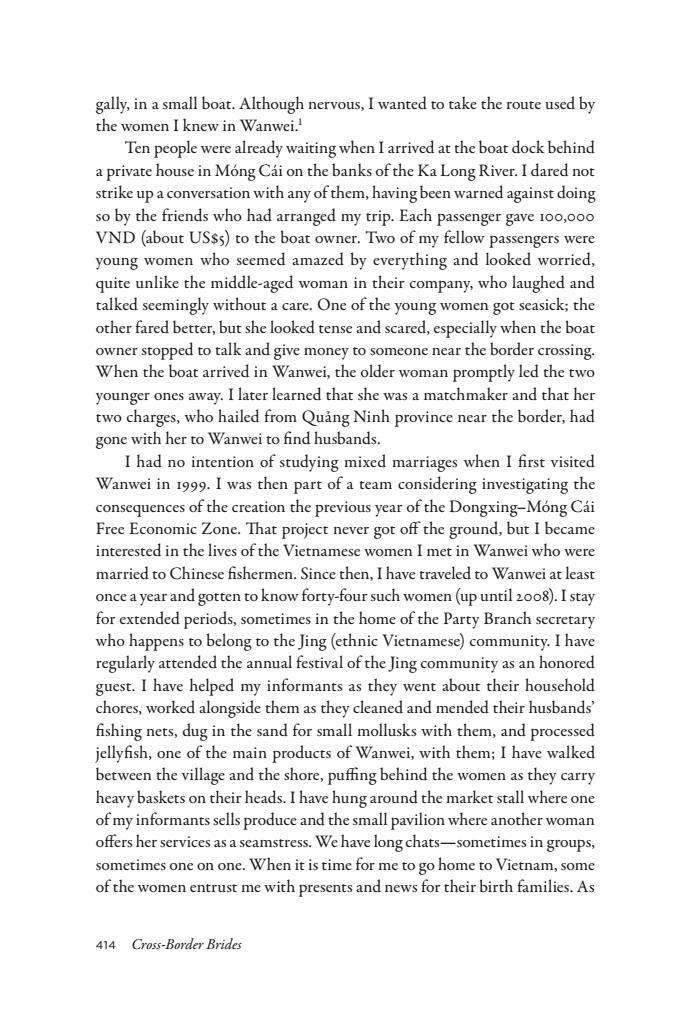正在加载图片...

gally,in a small boat.Although nervous,I wanted to take the route used by the women I knew in Wanwei. Ten people were already waiting when I arrived at the boat dock behind a private house in Mong Cai on the banks of the Ka Long River.I dared not strike up a conversation with any of them,having been warned against doing so by the friends who had arranged my trip.Each passenger gave 1oo,ooo VND (about USss)to the boat owner.Two of my fellow passengers were young women who seemed amazed by everything and looked worried, quite unlike the middle-aged woman in their company,who laughed and talked seemingly without a care.One of the young women got seasick;the other fared better,but she looked tense and scared,especially when the boat owner stopped to talk and give money to someone near the border crossing. When the boat arrived in Wanwei,the older woman promptly led the two younger ones away.I later learned that she was a matchmaker and that her two charges,who hailed from Quang Ninh province near the border,had gone with her to Wanwei to find husbands. I had no intention of studying mixed marriages when I first visited Wanwei in 1999.I was then part of a team considering investigating the consequences of the creation the previous year of the Dongxing-Mong Cai Free Economic Zone.That project never got off the ground,but I became interested in the lives of the Vietnamese women I met in Wanwei who were married to Chinese fishermen.Since then,I have traveled to Wanwei at least once a year and gotten to know forty-four such women(up until 2o08).I stay for extended periods,sometimes in the home of the Party Branch secretary who happens to belong to the Jing (ethnic Vietnamese)community.I have regularly attended the annual festival of the Jing community as an honored guest.I have helped my informants as they went about their household chores,worked alongside them as they cleaned and mended their husbands' fishing nets,dug in the sand for small mollusks with them,and processed jellyfish,one of the main products of Wanwei,with them;I have walked between the village and the shore,puffing behind the women as they carry heavy baskets on their heads.I have hung around the market stall where one of my informants sells produce and the small pavilion where another woman offers her services as a seamstress.We have long chats-sometimes in groups, sometimes one on one.When it is time for me to go home to Vietnam,some of the women entrust me with presents and news for their birth families.As 414 Cross-Border Bridesùõù Cross-Border Brides gally, in a small boat. Although nervous, I wanted to take the route used by the women I knew in Wanwei.1 Ten people were already waiting when I arrived at the boat dock behind a private house in Móng Cái on the banks of the Ka Long River. I dared not strike up a conversation with any of them, having been warned against doing so by the friends who had arranged my trip. Each passenger gave 100,000 VND (about US$5) to the boat owner. Two of my fellow passengers were young women who seemed amazed by everything and looked worried, quite unlike the middle-aged woman in their company, who laughed and talked seemingly without a care. One of the young women got seasick; the other fared better, but she looked tense and scared, especially when the boat owner stopped to talk and give money to someone near the border crossing. When the boat arrived in Wanwei, the older woman promptly led the two younger ones away. I later learned that she was a matchmaker and that her two charges, who hailed from Quảng Ninh province near the border, had gone with her to Wanwei to find husbands. I had no intention of studying mixed marriages when I first visited Wanwei in 1999. I was then part of a team considering investigating the consequences of the creation the previous year of the Dongxing–Móng Cái Free Economic Zone. That project never got off the ground, but I became interested in the lives of the Vietnamese women I met in Wanwei who were married to Chinese fishermen. Since then, I have traveled to Wanwei at least once a year and gotten to know forty-four such women (up until 2008). I stay for extended periods, sometimes in the home of the Party Branch secretary who happens to belong to the Jing (ethnic Vietnamese) community. I have regularly attended the annual festival of the Jing community as an honored guest. I have helped my informants as they went about their household chores, worked alongside them as they cleaned and mended their husbands’ fishing nets, dug in the sand for small mollusks with them, and processed jellyfish, one of the main products of Wanwei, with them; I have walked between the village and the shore, puffing behind the women as they carry heavy baskets on their heads. I have hung around the market stall where one of my informants sells produce and the small pavilion where another woman offers her services as a seamstress. We have long chats—sometimes in groups, sometimes one on one. When it is time for me to go home to Vietnam, some of the women entrust me with presents and news for their birth families. As